MKT3031: Entrepreneurial Strategy Report for Pip & Nut Company
VerifiedAdded on 2023/01/17
|11
|3751
|53
Report
AI Summary
This report provides a comprehensive analysis of Pip & Nut, a nut butter and healthy food company. It begins with an executive summary and an introduction to entrepreneurship, defining it as the process of converting ideas into a business. The main body includes a detailed situational analysis using PESTEL and VRIO frameworks to assess the company's internal and external environments, evaluating its political, economic, social, technological, environmental, and legal factors. The report then outlines the development of business objectives, such as maximizing sales and increasing profitability. It evaluates entrepreneurial strategies using the Ansoff matrix, focusing on market penetration, product development, market development, and diversification strategies. The report concludes with recommendations for effective strategies to foster growth and development for Pip & Nut, emphasizing the importance of adapting to market changes and leveraging its strengths.
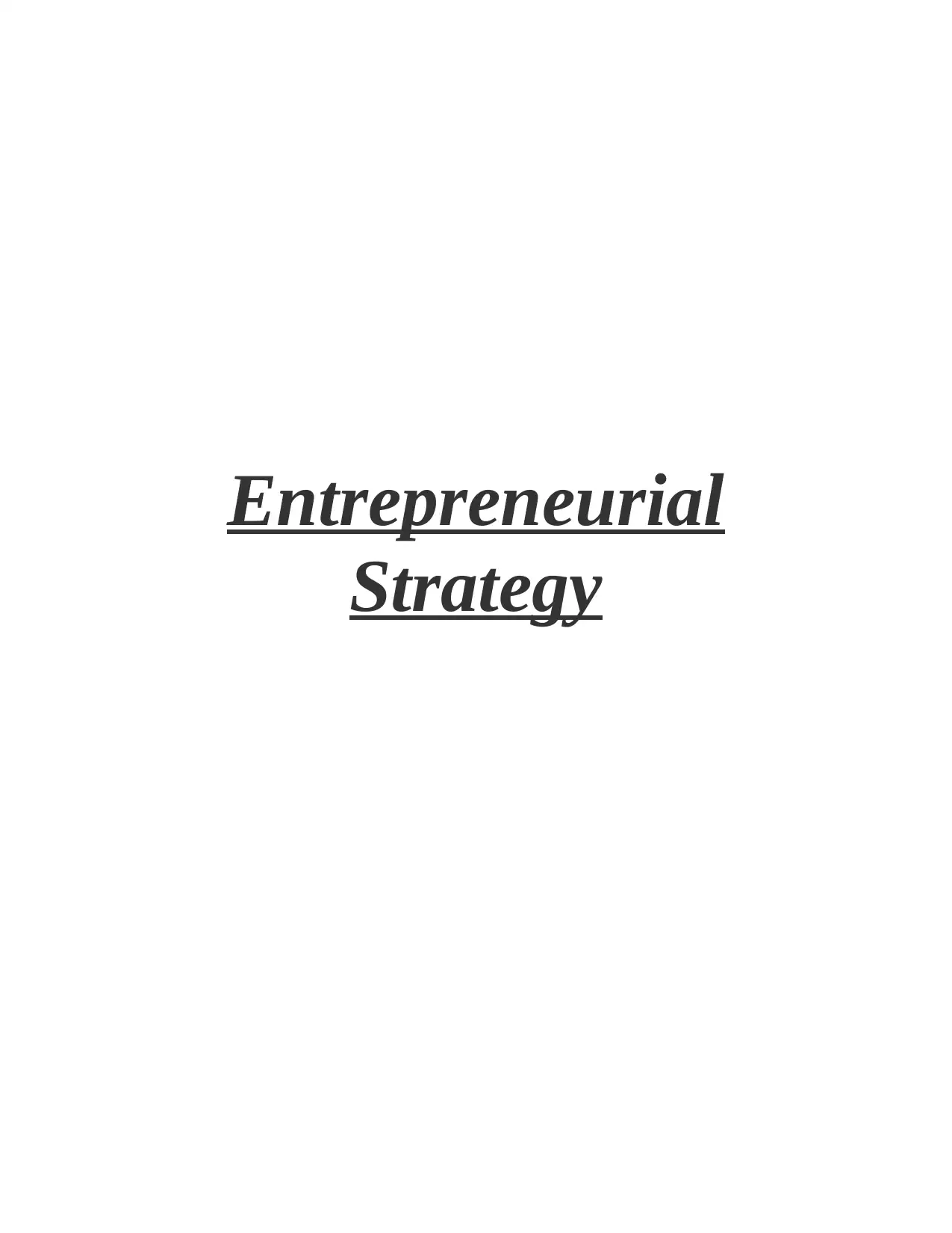
Entrepreneurial
Strategy
Strategy
Paraphrase This Document
Need a fresh take? Get an instant paraphrase of this document with our AI Paraphraser
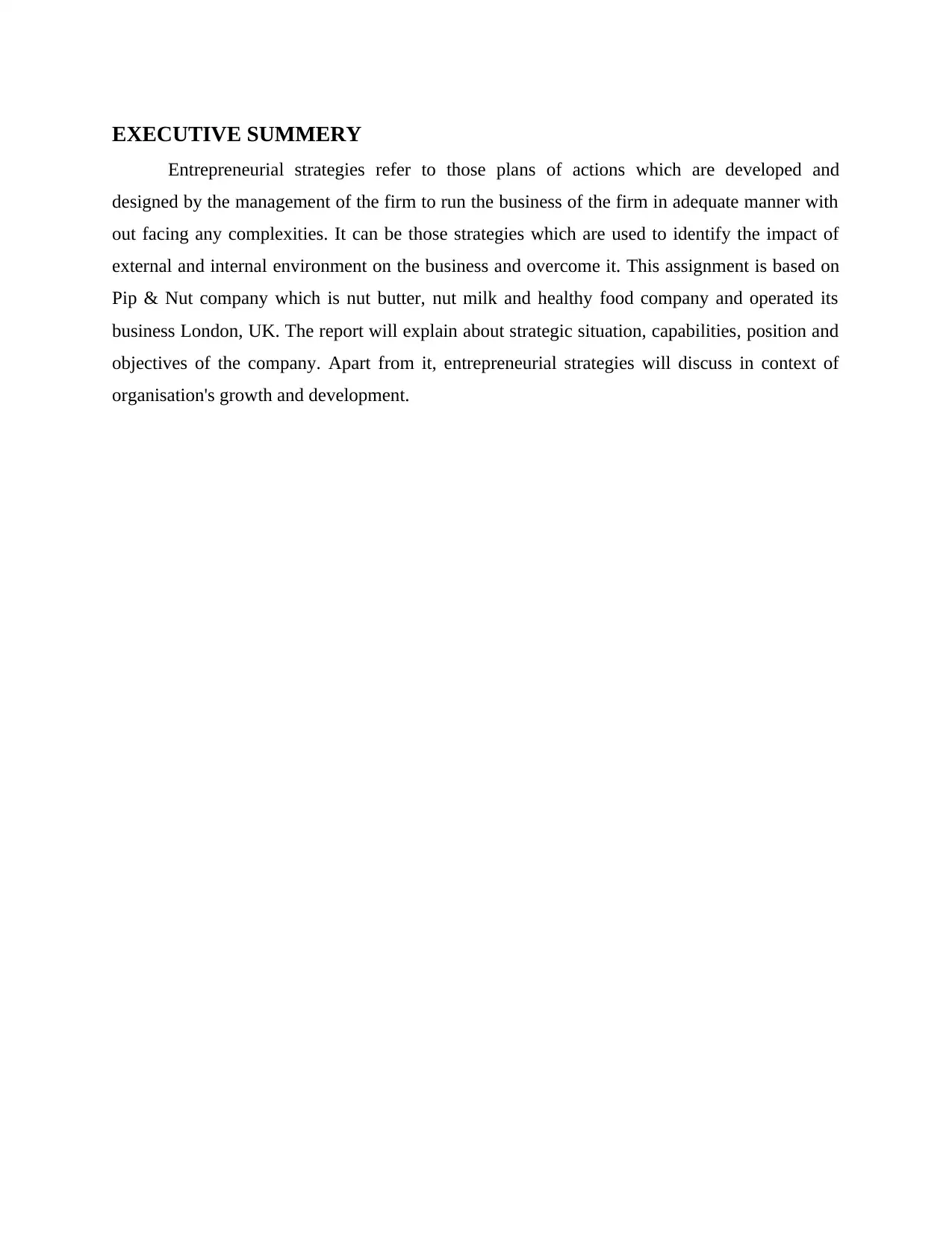
EXECUTIVE SUMMERY
Entrepreneurial strategies refer to those plans of actions which are developed and
designed by the management of the firm to run the business of the firm in adequate manner with
out facing any complexities. It can be those strategies which are used to identify the impact of
external and internal environment on the business and overcome it. This assignment is based on
Pip & Nut company which is nut butter, nut milk and healthy food company and operated its
business London, UK. The report will explain about strategic situation, capabilities, position and
objectives of the company. Apart from it, entrepreneurial strategies will discuss in context of
organisation's growth and development.
Entrepreneurial strategies refer to those plans of actions which are developed and
designed by the management of the firm to run the business of the firm in adequate manner with
out facing any complexities. It can be those strategies which are used to identify the impact of
external and internal environment on the business and overcome it. This assignment is based on
Pip & Nut company which is nut butter, nut milk and healthy food company and operated its
business London, UK. The report will explain about strategic situation, capabilities, position and
objectives of the company. Apart from it, entrepreneurial strategies will discuss in context of
organisation's growth and development.
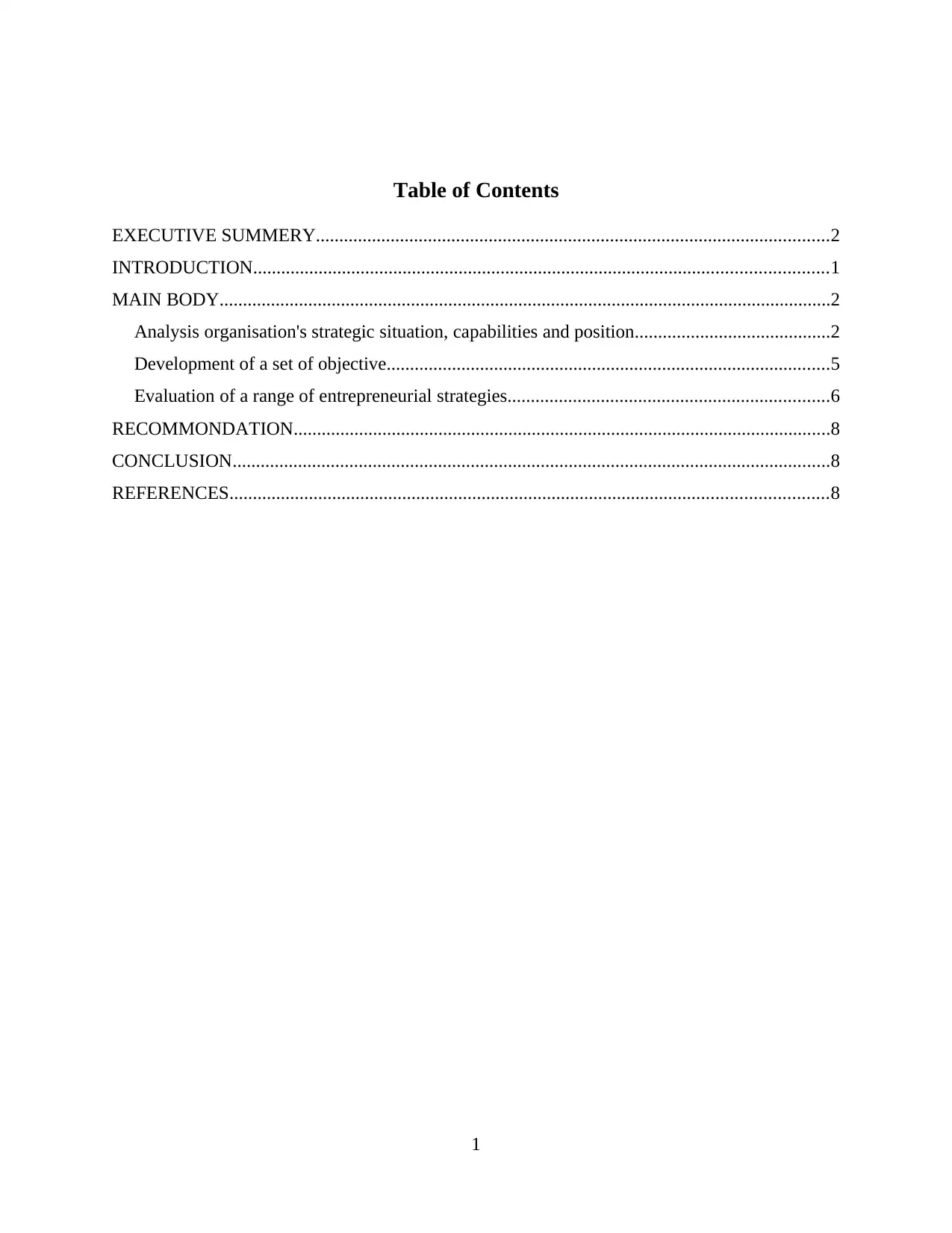
Table of Contents
EXECUTIVE SUMMERY..............................................................................................................2
INTRODUCTION...........................................................................................................................1
MAIN BODY...................................................................................................................................2
Analysis organisation's strategic situation, capabilities and position..........................................2
Development of a set of objective...............................................................................................5
Evaluation of a range of entrepreneurial strategies.....................................................................6
RECOMMONDATION...................................................................................................................8
CONCLUSION................................................................................................................................8
REFERENCES................................................................................................................................8
1
EXECUTIVE SUMMERY..............................................................................................................2
INTRODUCTION...........................................................................................................................1
MAIN BODY...................................................................................................................................2
Analysis organisation's strategic situation, capabilities and position..........................................2
Development of a set of objective...............................................................................................5
Evaluation of a range of entrepreneurial strategies.....................................................................6
RECOMMONDATION...................................................................................................................8
CONCLUSION................................................................................................................................8
REFERENCES................................................................................................................................8
1
⊘ This is a preview!⊘
Do you want full access?
Subscribe today to unlock all pages.

Trusted by 1+ million students worldwide
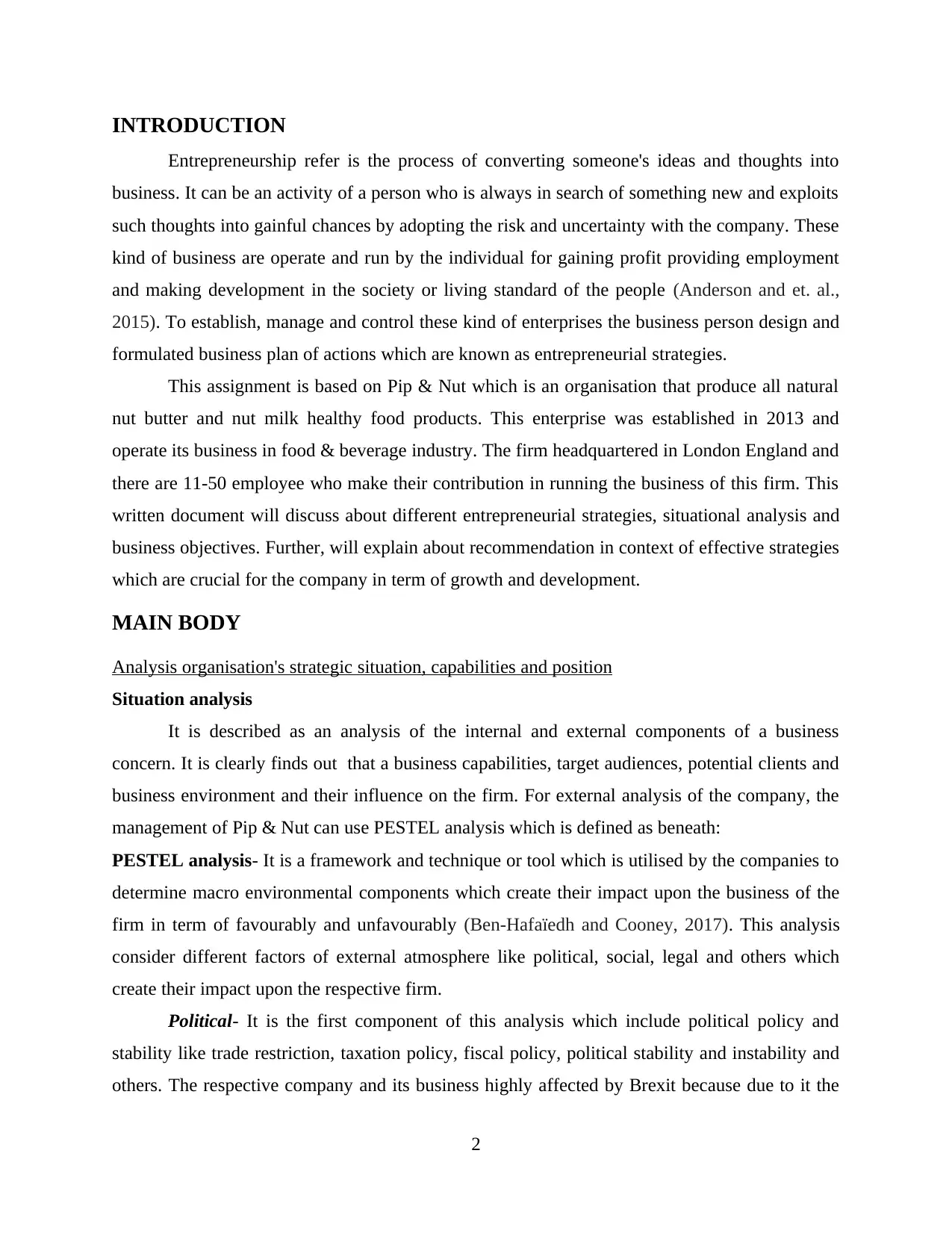
INTRODUCTION
Entrepreneurship refer is the process of converting someone's ideas and thoughts into
business. It can be an activity of a person who is always in search of something new and exploits
such thoughts into gainful chances by adopting the risk and uncertainty with the company. These
kind of business are operate and run by the individual for gaining profit providing employment
and making development in the society or living standard of the people (Anderson and et. al.,
2015). To establish, manage and control these kind of enterprises the business person design and
formulated business plan of actions which are known as entrepreneurial strategies.
This assignment is based on Pip & Nut which is an organisation that produce all natural
nut butter and nut milk healthy food products. This enterprise was established in 2013 and
operate its business in food & beverage industry. The firm headquartered in London England and
there are 11-50 employee who make their contribution in running the business of this firm. This
written document will discuss about different entrepreneurial strategies, situational analysis and
business objectives. Further, will explain about recommendation in context of effective strategies
which are crucial for the company in term of growth and development.
MAIN BODY
Analysis organisation's strategic situation, capabilities and position
Situation analysis
It is described as an analysis of the internal and external components of a business
concern. It is clearly finds out that a business capabilities, target audiences, potential clients and
business environment and their influence on the firm. For external analysis of the company, the
management of Pip & Nut can use PESTEL analysis which is defined as beneath:
PESTEL analysis- It is a framework and technique or tool which is utilised by the companies to
determine macro environmental components which create their impact upon the business of the
firm in term of favourably and unfavourably (Ben-Hafaïedh and Cooney, 2017). This analysis
consider different factors of external atmosphere like political, social, legal and others which
create their impact upon the respective firm.
Political- It is the first component of this analysis which include political policy and
stability like trade restriction, taxation policy, fiscal policy, political stability and instability and
others. The respective company and its business highly affected by Brexit because due to it the
2
Entrepreneurship refer is the process of converting someone's ideas and thoughts into
business. It can be an activity of a person who is always in search of something new and exploits
such thoughts into gainful chances by adopting the risk and uncertainty with the company. These
kind of business are operate and run by the individual for gaining profit providing employment
and making development in the society or living standard of the people (Anderson and et. al.,
2015). To establish, manage and control these kind of enterprises the business person design and
formulated business plan of actions which are known as entrepreneurial strategies.
This assignment is based on Pip & Nut which is an organisation that produce all natural
nut butter and nut milk healthy food products. This enterprise was established in 2013 and
operate its business in food & beverage industry. The firm headquartered in London England and
there are 11-50 employee who make their contribution in running the business of this firm. This
written document will discuss about different entrepreneurial strategies, situational analysis and
business objectives. Further, will explain about recommendation in context of effective strategies
which are crucial for the company in term of growth and development.
MAIN BODY
Analysis organisation's strategic situation, capabilities and position
Situation analysis
It is described as an analysis of the internal and external components of a business
concern. It is clearly finds out that a business capabilities, target audiences, potential clients and
business environment and their influence on the firm. For external analysis of the company, the
management of Pip & Nut can use PESTEL analysis which is defined as beneath:
PESTEL analysis- It is a framework and technique or tool which is utilised by the companies to
determine macro environmental components which create their impact upon the business of the
firm in term of favourably and unfavourably (Ben-Hafaïedh and Cooney, 2017). This analysis
consider different factors of external atmosphere like political, social, legal and others which
create their impact upon the respective firm.
Political- It is the first component of this analysis which include political policy and
stability like trade restriction, taxation policy, fiscal policy, political stability and instability and
others. The respective company and its business highly affected by Brexit because due to it the
2
Paraphrase This Document
Need a fresh take? Get an instant paraphrase of this document with our AI Paraphraser
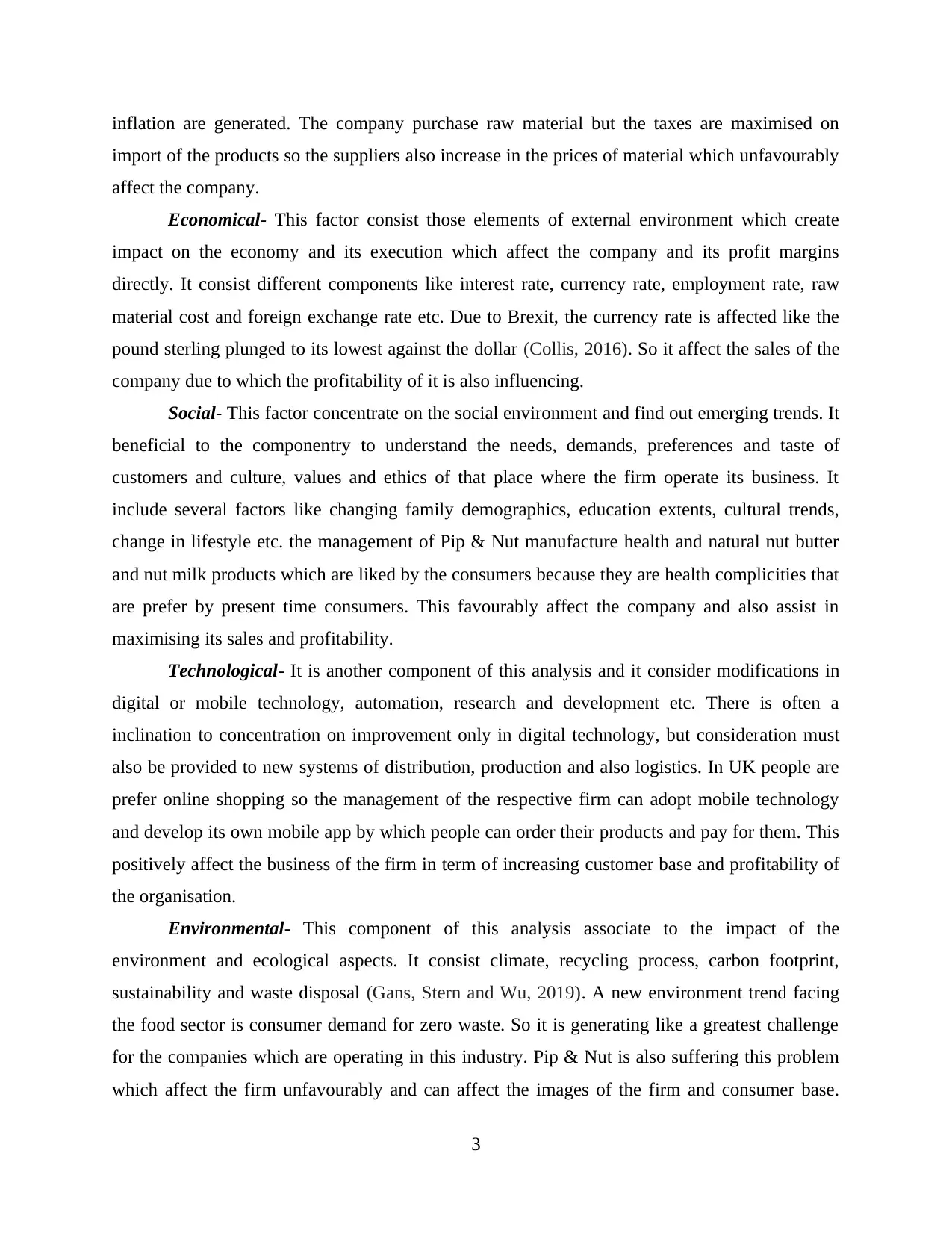
inflation are generated. The company purchase raw material but the taxes are maximised on
import of the products so the suppliers also increase in the prices of material which unfavourably
affect the company.
Economical- This factor consist those elements of external environment which create
impact on the economy and its execution which affect the company and its profit margins
directly. It consist different components like interest rate, currency rate, employment rate, raw
material cost and foreign exchange rate etc. Due to Brexit, the currency rate is affected like the
pound sterling plunged to its lowest against the dollar (Collis, 2016). So it affect the sales of the
company due to which the profitability of it is also influencing.
Social- This factor concentrate on the social environment and find out emerging trends. It
beneficial to the componentry to understand the needs, demands, preferences and taste of
customers and culture, values and ethics of that place where the firm operate its business. It
include several factors like changing family demographics, education extents, cultural trends,
change in lifestyle etc. the management of Pip & Nut manufacture health and natural nut butter
and nut milk products which are liked by the consumers because they are health complicities that
are prefer by present time consumers. This favourably affect the company and also assist in
maximising its sales and profitability.
Technological- It is another component of this analysis and it consider modifications in
digital or mobile technology, automation, research and development etc. There is often a
inclination to concentration on improvement only in digital technology, but consideration must
also be provided to new systems of distribution, production and also logistics. In UK people are
prefer online shopping so the management of the respective firm can adopt mobile technology
and develop its own mobile app by which people can order their products and pay for them. This
positively affect the business of the firm in term of increasing customer base and profitability of
the organisation.
Environmental- This component of this analysis associate to the impact of the
environment and ecological aspects. It consist climate, recycling process, carbon footprint,
sustainability and waste disposal (Gans, Stern and Wu, 2019). A new environment trend facing
the food sector is consumer demand for zero waste. So it is generating like a greatest challenge
for the companies which are operating in this industry. Pip & Nut is also suffering this problem
which affect the firm unfavourably and can affect the images of the firm and consumer base.
3
import of the products so the suppliers also increase in the prices of material which unfavourably
affect the company.
Economical- This factor consist those elements of external environment which create
impact on the economy and its execution which affect the company and its profit margins
directly. It consist different components like interest rate, currency rate, employment rate, raw
material cost and foreign exchange rate etc. Due to Brexit, the currency rate is affected like the
pound sterling plunged to its lowest against the dollar (Collis, 2016). So it affect the sales of the
company due to which the profitability of it is also influencing.
Social- This factor concentrate on the social environment and find out emerging trends. It
beneficial to the componentry to understand the needs, demands, preferences and taste of
customers and culture, values and ethics of that place where the firm operate its business. It
include several factors like changing family demographics, education extents, cultural trends,
change in lifestyle etc. the management of Pip & Nut manufacture health and natural nut butter
and nut milk products which are liked by the consumers because they are health complicities that
are prefer by present time consumers. This favourably affect the company and also assist in
maximising its sales and profitability.
Technological- It is another component of this analysis and it consider modifications in
digital or mobile technology, automation, research and development etc. There is often a
inclination to concentration on improvement only in digital technology, but consideration must
also be provided to new systems of distribution, production and also logistics. In UK people are
prefer online shopping so the management of the respective firm can adopt mobile technology
and develop its own mobile app by which people can order their products and pay for them. This
positively affect the business of the firm in term of increasing customer base and profitability of
the organisation.
Environmental- This component of this analysis associate to the impact of the
environment and ecological aspects. It consist climate, recycling process, carbon footprint,
sustainability and waste disposal (Gans, Stern and Wu, 2019). A new environment trend facing
the food sector is consumer demand for zero waste. So it is generating like a greatest challenge
for the companies which are operating in this industry. Pip & Nut is also suffering this problem
which affect the firm unfavourably and can affect the images of the firm and consumer base.
3
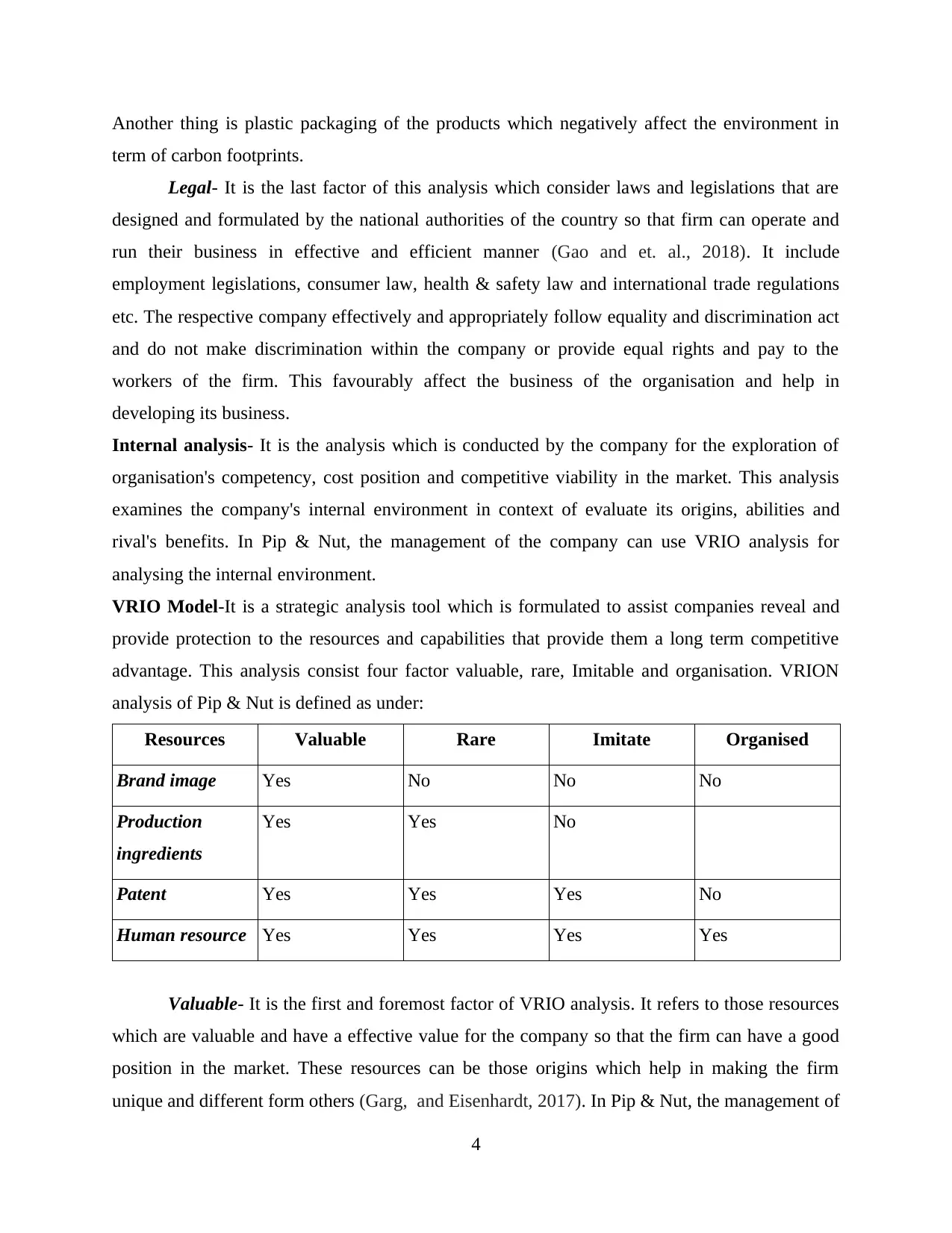
Another thing is plastic packaging of the products which negatively affect the environment in
term of carbon footprints.
Legal- It is the last factor of this analysis which consider laws and legislations that are
designed and formulated by the national authorities of the country so that firm can operate and
run their business in effective and efficient manner (Gao and et. al., 2018). It include
employment legislations, consumer law, health & safety law and international trade regulations
etc. The respective company effectively and appropriately follow equality and discrimination act
and do not make discrimination within the company or provide equal rights and pay to the
workers of the firm. This favourably affect the business of the organisation and help in
developing its business.
Internal analysis- It is the analysis which is conducted by the company for the exploration of
organisation's competency, cost position and competitive viability in the market. This analysis
examines the company's internal environment in context of evaluate its origins, abilities and
rival's benefits. In Pip & Nut, the management of the company can use VRIO analysis for
analysing the internal environment.
VRIO Model-It is a strategic analysis tool which is formulated to assist companies reveal and
provide protection to the resources and capabilities that provide them a long term competitive
advantage. This analysis consist four factor valuable, rare, Imitable and organisation. VRION
analysis of Pip & Nut is defined as under:
Resources Valuable Rare Imitate Organised
Brand image Yes No No No
Production
ingredients
Yes Yes No
Patent Yes Yes Yes No
Human resource Yes Yes Yes Yes
Valuable- It is the first and foremost factor of VRIO analysis. It refers to those resources
which are valuable and have a effective value for the company so that the firm can have a good
position in the market. These resources can be those origins which help in making the firm
unique and different form others (Garg, and Eisenhardt, 2017). In Pip & Nut, the management of
4
term of carbon footprints.
Legal- It is the last factor of this analysis which consider laws and legislations that are
designed and formulated by the national authorities of the country so that firm can operate and
run their business in effective and efficient manner (Gao and et. al., 2018). It include
employment legislations, consumer law, health & safety law and international trade regulations
etc. The respective company effectively and appropriately follow equality and discrimination act
and do not make discrimination within the company or provide equal rights and pay to the
workers of the firm. This favourably affect the business of the organisation and help in
developing its business.
Internal analysis- It is the analysis which is conducted by the company for the exploration of
organisation's competency, cost position and competitive viability in the market. This analysis
examines the company's internal environment in context of evaluate its origins, abilities and
rival's benefits. In Pip & Nut, the management of the company can use VRIO analysis for
analysing the internal environment.
VRIO Model-It is a strategic analysis tool which is formulated to assist companies reveal and
provide protection to the resources and capabilities that provide them a long term competitive
advantage. This analysis consist four factor valuable, rare, Imitable and organisation. VRION
analysis of Pip & Nut is defined as under:
Resources Valuable Rare Imitate Organised
Brand image Yes No No No
Production
ingredients
Yes Yes No
Patent Yes Yes Yes No
Human resource Yes Yes Yes Yes
Valuable- It is the first and foremost factor of VRIO analysis. It refers to those resources
which are valuable and have a effective value for the company so that the firm can have a good
position in the market. These resources can be those origins which help in making the firm
unique and different form others (Garg, and Eisenhardt, 2017). In Pip & Nut, the management of
4
⊘ This is a preview!⊘
Do you want full access?
Subscribe today to unlock all pages.

Trusted by 1+ million students worldwide
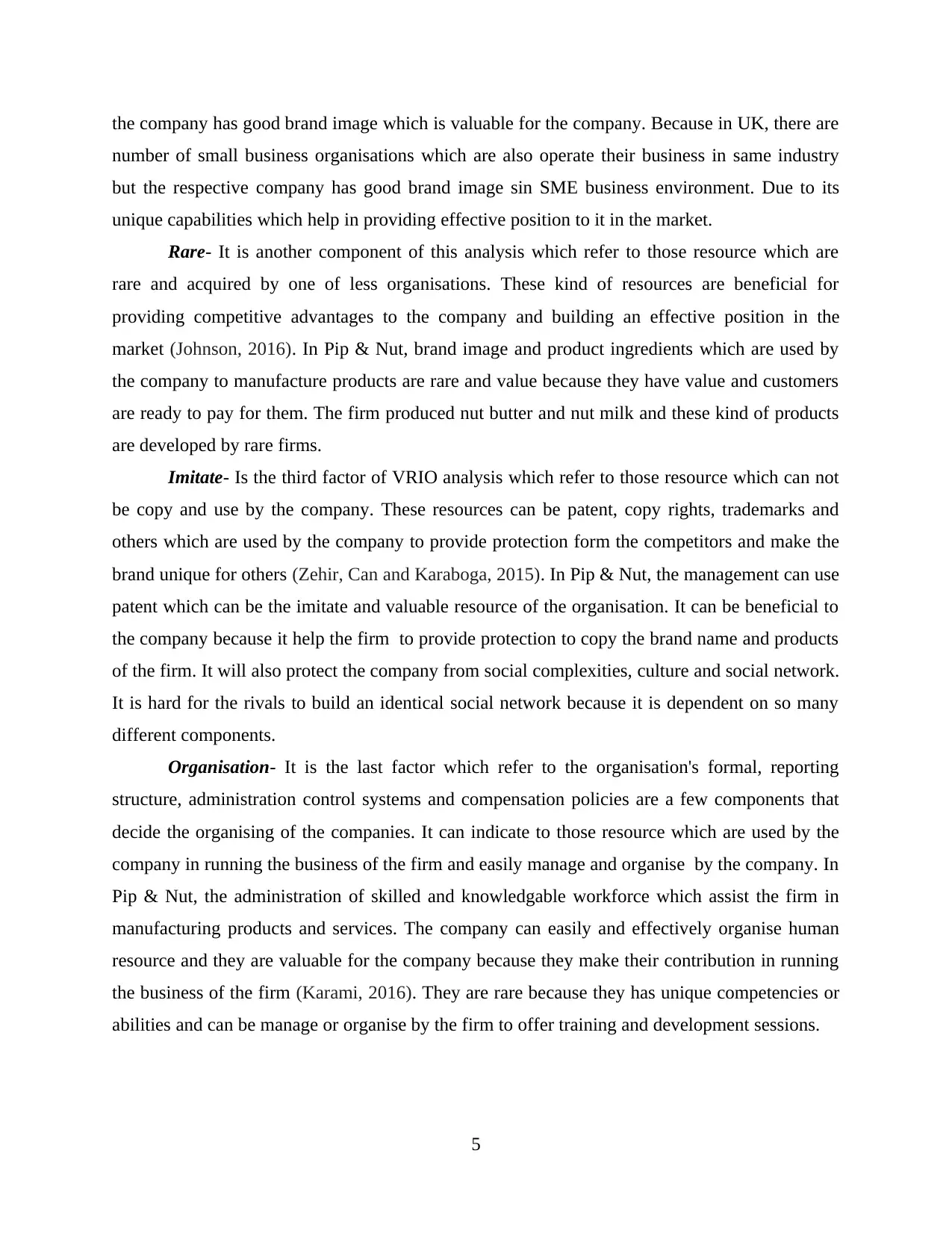
the company has good brand image which is valuable for the company. Because in UK, there are
number of small business organisations which are also operate their business in same industry
but the respective company has good brand image sin SME business environment. Due to its
unique capabilities which help in providing effective position to it in the market.
Rare- It is another component of this analysis which refer to those resource which are
rare and acquired by one of less organisations. These kind of resources are beneficial for
providing competitive advantages to the company and building an effective position in the
market (Johnson, 2016). In Pip & Nut, brand image and product ingredients which are used by
the company to manufacture products are rare and value because they have value and customers
are ready to pay for them. The firm produced nut butter and nut milk and these kind of products
are developed by rare firms.
Imitate- Is the third factor of VRIO analysis which refer to those resource which can not
be copy and use by the company. These resources can be patent, copy rights, trademarks and
others which are used by the company to provide protection form the competitors and make the
brand unique for others (Zehir, Can and Karaboga, 2015). In Pip & Nut, the management can use
patent which can be the imitate and valuable resource of the organisation. It can be beneficial to
the company because it help the firm to provide protection to copy the brand name and products
of the firm. It will also protect the company from social complexities, culture and social network.
It is hard for the rivals to build an identical social network because it is dependent on so many
different components.
Organisation- It is the last factor which refer to the organisation's formal, reporting
structure, administration control systems and compensation policies are a few components that
decide the organising of the companies. It can indicate to those resource which are used by the
company in running the business of the firm and easily manage and organise by the company. In
Pip & Nut, the administration of skilled and knowledgable workforce which assist the firm in
manufacturing products and services. The company can easily and effectively organise human
resource and they are valuable for the company because they make their contribution in running
the business of the firm (Karami, 2016). They are rare because they has unique competencies or
abilities and can be manage or organise by the firm to offer training and development sessions.
5
number of small business organisations which are also operate their business in same industry
but the respective company has good brand image sin SME business environment. Due to its
unique capabilities which help in providing effective position to it in the market.
Rare- It is another component of this analysis which refer to those resource which are
rare and acquired by one of less organisations. These kind of resources are beneficial for
providing competitive advantages to the company and building an effective position in the
market (Johnson, 2016). In Pip & Nut, brand image and product ingredients which are used by
the company to manufacture products are rare and value because they have value and customers
are ready to pay for them. The firm produced nut butter and nut milk and these kind of products
are developed by rare firms.
Imitate- Is the third factor of VRIO analysis which refer to those resource which can not
be copy and use by the company. These resources can be patent, copy rights, trademarks and
others which are used by the company to provide protection form the competitors and make the
brand unique for others (Zehir, Can and Karaboga, 2015). In Pip & Nut, the management can use
patent which can be the imitate and valuable resource of the organisation. It can be beneficial to
the company because it help the firm to provide protection to copy the brand name and products
of the firm. It will also protect the company from social complexities, culture and social network.
It is hard for the rivals to build an identical social network because it is dependent on so many
different components.
Organisation- It is the last factor which refer to the organisation's formal, reporting
structure, administration control systems and compensation policies are a few components that
decide the organising of the companies. It can indicate to those resource which are used by the
company in running the business of the firm and easily manage and organise by the company. In
Pip & Nut, the administration of skilled and knowledgable workforce which assist the firm in
manufacturing products and services. The company can easily and effectively organise human
resource and they are valuable for the company because they make their contribution in running
the business of the firm (Karami, 2016). They are rare because they has unique competencies or
abilities and can be manage or organise by the firm to offer training and development sessions.
5
Paraphrase This Document
Need a fresh take? Get an instant paraphrase of this document with our AI Paraphraser
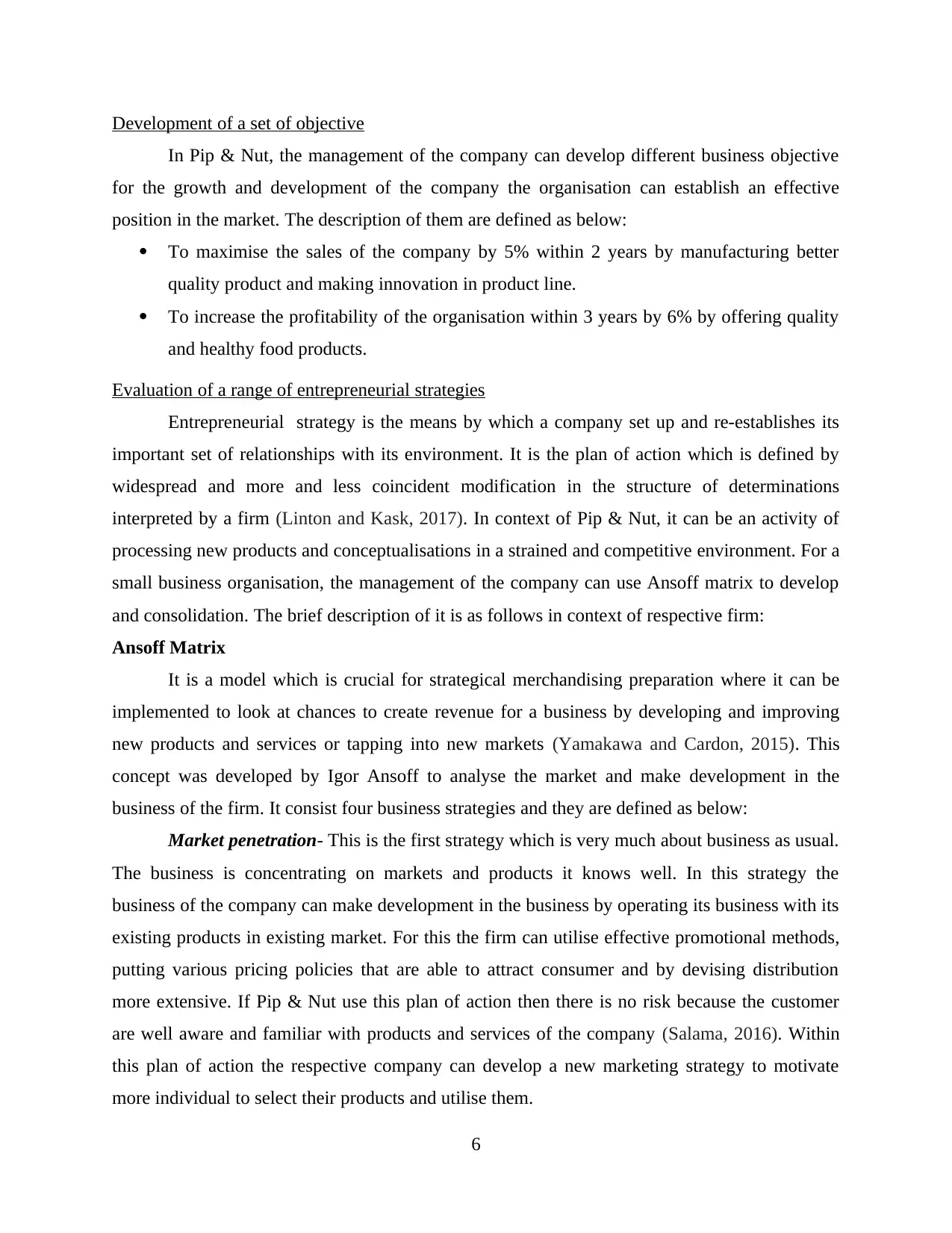
Development of a set of objective
In Pip & Nut, the management of the company can develop different business objective
for the growth and development of the company the organisation can establish an effective
position in the market. The description of them are defined as below:
To maximise the sales of the company by 5% within 2 years by manufacturing better
quality product and making innovation in product line.
To increase the profitability of the organisation within 3 years by 6% by offering quality
and healthy food products.
Evaluation of a range of entrepreneurial strategies
Entrepreneurial strategy is the means by which a company set up and re-establishes its
important set of relationships with its environment. It is the plan of action which is defined by
widespread and more and less coincident modification in the structure of determinations
interpreted by a firm (Linton and Kask, 2017). In context of Pip & Nut, it can be an activity of
processing new products and conceptualisations in a strained and competitive environment. For a
small business organisation, the management of the company can use Ansoff matrix to develop
and consolidation. The brief description of it is as follows in context of respective firm:
Ansoff Matrix
It is a model which is crucial for strategical merchandising preparation where it can be
implemented to look at chances to create revenue for a business by developing and improving
new products and services or tapping into new markets (Yamakawa and Cardon, 2015). This
concept was developed by Igor Ansoff to analyse the market and make development in the
business of the firm. It consist four business strategies and they are defined as below:
Market penetration- This is the first strategy which is very much about business as usual.
The business is concentrating on markets and products it knows well. In this strategy the
business of the company can make development in the business by operating its business with its
existing products in existing market. For this the firm can utilise effective promotional methods,
putting various pricing policies that are able to attract consumer and by devising distribution
more extensive. If Pip & Nut use this plan of action then there is no risk because the customer
are well aware and familiar with products and services of the company (Salama, 2016). Within
this plan of action the respective company can develop a new marketing strategy to motivate
more individual to select their products and utilise them.
6
In Pip & Nut, the management of the company can develop different business objective
for the growth and development of the company the organisation can establish an effective
position in the market. The description of them are defined as below:
To maximise the sales of the company by 5% within 2 years by manufacturing better
quality product and making innovation in product line.
To increase the profitability of the organisation within 3 years by 6% by offering quality
and healthy food products.
Evaluation of a range of entrepreneurial strategies
Entrepreneurial strategy is the means by which a company set up and re-establishes its
important set of relationships with its environment. It is the plan of action which is defined by
widespread and more and less coincident modification in the structure of determinations
interpreted by a firm (Linton and Kask, 2017). In context of Pip & Nut, it can be an activity of
processing new products and conceptualisations in a strained and competitive environment. For a
small business organisation, the management of the company can use Ansoff matrix to develop
and consolidation. The brief description of it is as follows in context of respective firm:
Ansoff Matrix
It is a model which is crucial for strategical merchandising preparation where it can be
implemented to look at chances to create revenue for a business by developing and improving
new products and services or tapping into new markets (Yamakawa and Cardon, 2015). This
concept was developed by Igor Ansoff to analyse the market and make development in the
business of the firm. It consist four business strategies and they are defined as below:
Market penetration- This is the first strategy which is very much about business as usual.
The business is concentrating on markets and products it knows well. In this strategy the
business of the company can make development in the business by operating its business with its
existing products in existing market. For this the firm can utilise effective promotional methods,
putting various pricing policies that are able to attract consumer and by devising distribution
more extensive. If Pip & Nut use this plan of action then there is no risk because the customer
are well aware and familiar with products and services of the company (Salama, 2016). Within
this plan of action the respective company can develop a new marketing strategy to motivate
more individual to select their products and utilise them.
6
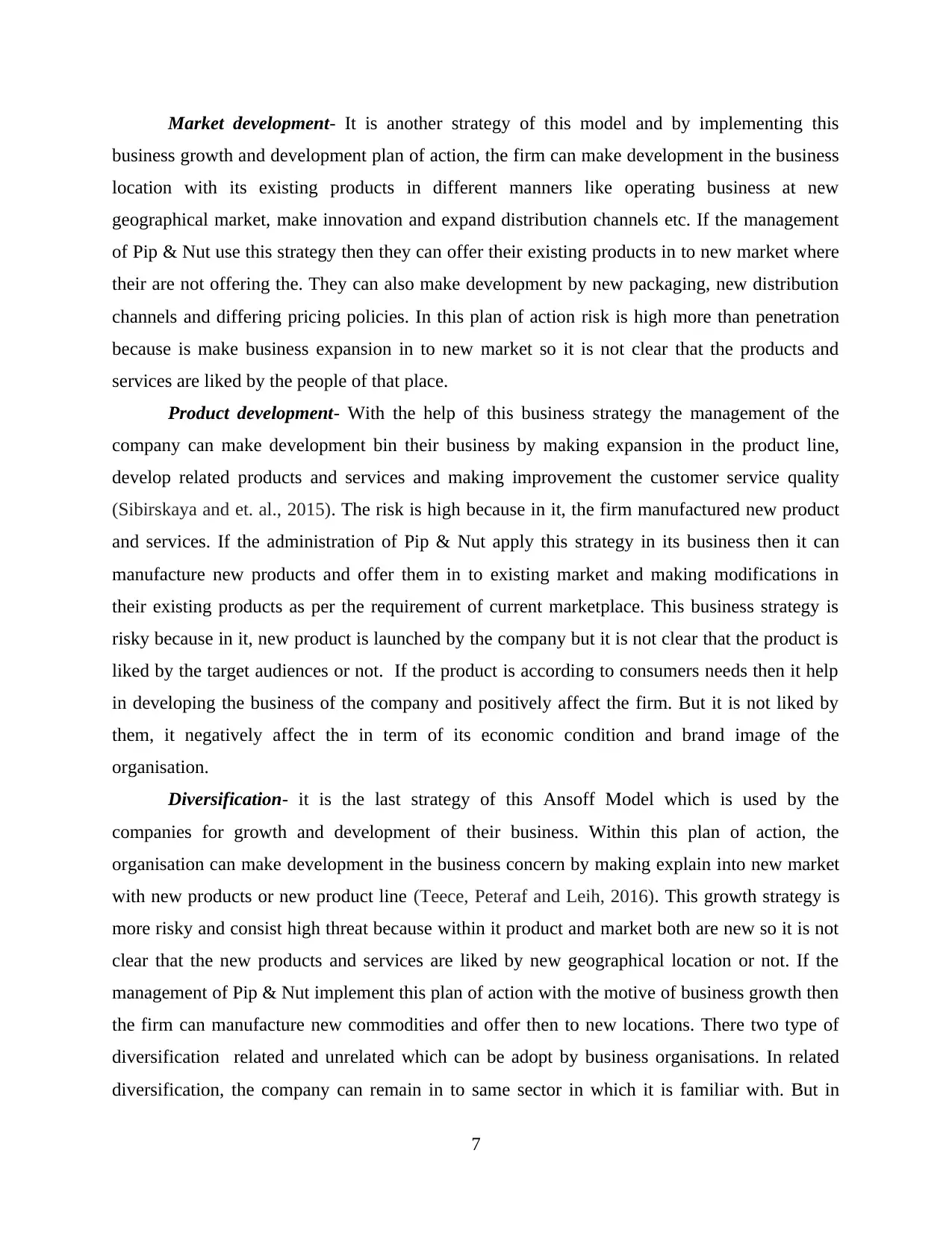
Market development- It is another strategy of this model and by implementing this
business growth and development plan of action, the firm can make development in the business
location with its existing products in different manners like operating business at new
geographical market, make innovation and expand distribution channels etc. If the management
of Pip & Nut use this strategy then they can offer their existing products in to new market where
their are not offering the. They can also make development by new packaging, new distribution
channels and differing pricing policies. In this plan of action risk is high more than penetration
because is make business expansion in to new market so it is not clear that the products and
services are liked by the people of that place.
Product development- With the help of this business strategy the management of the
company can make development bin their business by making expansion in the product line,
develop related products and services and making improvement the customer service quality
(Sibirskaya and et. al., 2015). The risk is high because in it, the firm manufactured new product
and services. If the administration of Pip & Nut apply this strategy in its business then it can
manufacture new products and offer them in to existing market and making modifications in
their existing products as per the requirement of current marketplace. This business strategy is
risky because in it, new product is launched by the company but it is not clear that the product is
liked by the target audiences or not. If the product is according to consumers needs then it help
in developing the business of the company and positively affect the firm. But it is not liked by
them, it negatively affect the in term of its economic condition and brand image of the
organisation.
Diversification- it is the last strategy of this Ansoff Model which is used by the
companies for growth and development of their business. Within this plan of action, the
organisation can make development in the business concern by making explain into new market
with new products or new product line (Teece, Peteraf and Leih, 2016). This growth strategy is
more risky and consist high threat because within it product and market both are new so it is not
clear that the new products and services are liked by new geographical location or not. If the
management of Pip & Nut implement this plan of action with the motive of business growth then
the firm can manufacture new commodities and offer then to new locations. There two type of
diversification related and unrelated which can be adopt by business organisations. In related
diversification, the company can remain in to same sector in which it is familiar with. But in
7
business growth and development plan of action, the firm can make development in the business
location with its existing products in different manners like operating business at new
geographical market, make innovation and expand distribution channels etc. If the management
of Pip & Nut use this strategy then they can offer their existing products in to new market where
their are not offering the. They can also make development by new packaging, new distribution
channels and differing pricing policies. In this plan of action risk is high more than penetration
because is make business expansion in to new market so it is not clear that the products and
services are liked by the people of that place.
Product development- With the help of this business strategy the management of the
company can make development bin their business by making expansion in the product line,
develop related products and services and making improvement the customer service quality
(Sibirskaya and et. al., 2015). The risk is high because in it, the firm manufactured new product
and services. If the administration of Pip & Nut apply this strategy in its business then it can
manufacture new products and offer them in to existing market and making modifications in
their existing products as per the requirement of current marketplace. This business strategy is
risky because in it, new product is launched by the company but it is not clear that the product is
liked by the target audiences or not. If the product is according to consumers needs then it help
in developing the business of the company and positively affect the firm. But it is not liked by
them, it negatively affect the in term of its economic condition and brand image of the
organisation.
Diversification- it is the last strategy of this Ansoff Model which is used by the
companies for growth and development of their business. Within this plan of action, the
organisation can make development in the business concern by making explain into new market
with new products or new product line (Teece, Peteraf and Leih, 2016). This growth strategy is
more risky and consist high threat because within it product and market both are new so it is not
clear that the new products and services are liked by new geographical location or not. If the
management of Pip & Nut implement this plan of action with the motive of business growth then
the firm can manufacture new commodities and offer then to new locations. There two type of
diversification related and unrelated which can be adopt by business organisations. In related
diversification, the company can remain in to same sector in which it is familiar with. But in
7
⊘ This is a preview!⊘
Do you want full access?
Subscribe today to unlock all pages.

Trusted by 1+ million students worldwide
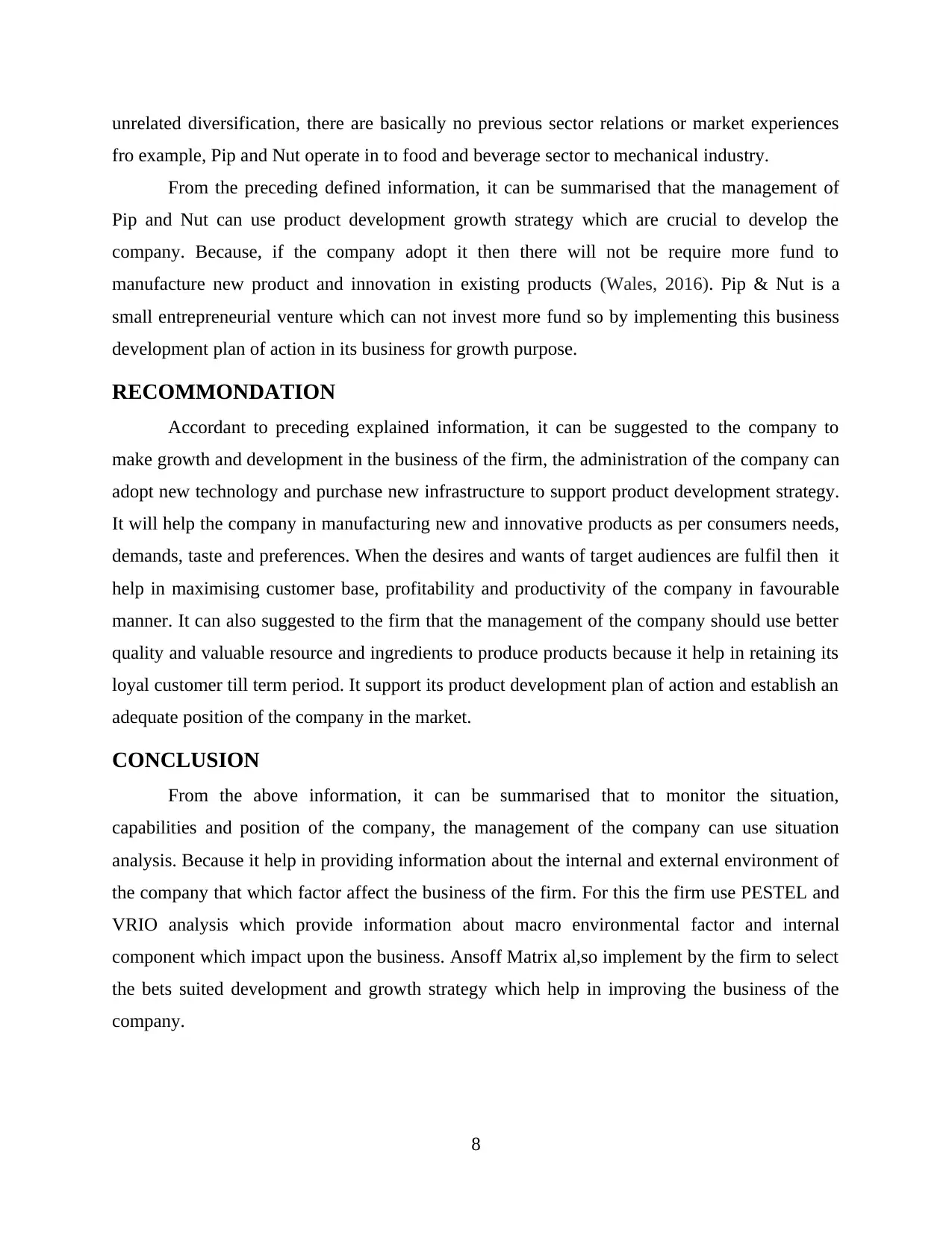
unrelated diversification, there are basically no previous sector relations or market experiences
fro example, Pip and Nut operate in to food and beverage sector to mechanical industry.
From the preceding defined information, it can be summarised that the management of
Pip and Nut can use product development growth strategy which are crucial to develop the
company. Because, if the company adopt it then there will not be require more fund to
manufacture new product and innovation in existing products (Wales, 2016). Pip & Nut is a
small entrepreneurial venture which can not invest more fund so by implementing this business
development plan of action in its business for growth purpose.
RECOMMONDATION
Accordant to preceding explained information, it can be suggested to the company to
make growth and development in the business of the firm, the administration of the company can
adopt new technology and purchase new infrastructure to support product development strategy.
It will help the company in manufacturing new and innovative products as per consumers needs,
demands, taste and preferences. When the desires and wants of target audiences are fulfil then it
help in maximising customer base, profitability and productivity of the company in favourable
manner. It can also suggested to the firm that the management of the company should use better
quality and valuable resource and ingredients to produce products because it help in retaining its
loyal customer till term period. It support its product development plan of action and establish an
adequate position of the company in the market.
CONCLUSION
From the above information, it can be summarised that to monitor the situation,
capabilities and position of the company, the management of the company can use situation
analysis. Because it help in providing information about the internal and external environment of
the company that which factor affect the business of the firm. For this the firm use PESTEL and
VRIO analysis which provide information about macro environmental factor and internal
component which impact upon the business. Ansoff Matrix al,so implement by the firm to select
the bets suited development and growth strategy which help in improving the business of the
company.
8
fro example, Pip and Nut operate in to food and beverage sector to mechanical industry.
From the preceding defined information, it can be summarised that the management of
Pip and Nut can use product development growth strategy which are crucial to develop the
company. Because, if the company adopt it then there will not be require more fund to
manufacture new product and innovation in existing products (Wales, 2016). Pip & Nut is a
small entrepreneurial venture which can not invest more fund so by implementing this business
development plan of action in its business for growth purpose.
RECOMMONDATION
Accordant to preceding explained information, it can be suggested to the company to
make growth and development in the business of the firm, the administration of the company can
adopt new technology and purchase new infrastructure to support product development strategy.
It will help the company in manufacturing new and innovative products as per consumers needs,
demands, taste and preferences. When the desires and wants of target audiences are fulfil then it
help in maximising customer base, profitability and productivity of the company in favourable
manner. It can also suggested to the firm that the management of the company should use better
quality and valuable resource and ingredients to produce products because it help in retaining its
loyal customer till term period. It support its product development plan of action and establish an
adequate position of the company in the market.
CONCLUSION
From the above information, it can be summarised that to monitor the situation,
capabilities and position of the company, the management of the company can use situation
analysis. Because it help in providing information about the internal and external environment of
the company that which factor affect the business of the firm. For this the firm use PESTEL and
VRIO analysis which provide information about macro environmental factor and internal
component which impact upon the business. Ansoff Matrix al,so implement by the firm to select
the bets suited development and growth strategy which help in improving the business of the
company.
8
Paraphrase This Document
Need a fresh take? Get an instant paraphrase of this document with our AI Paraphraser
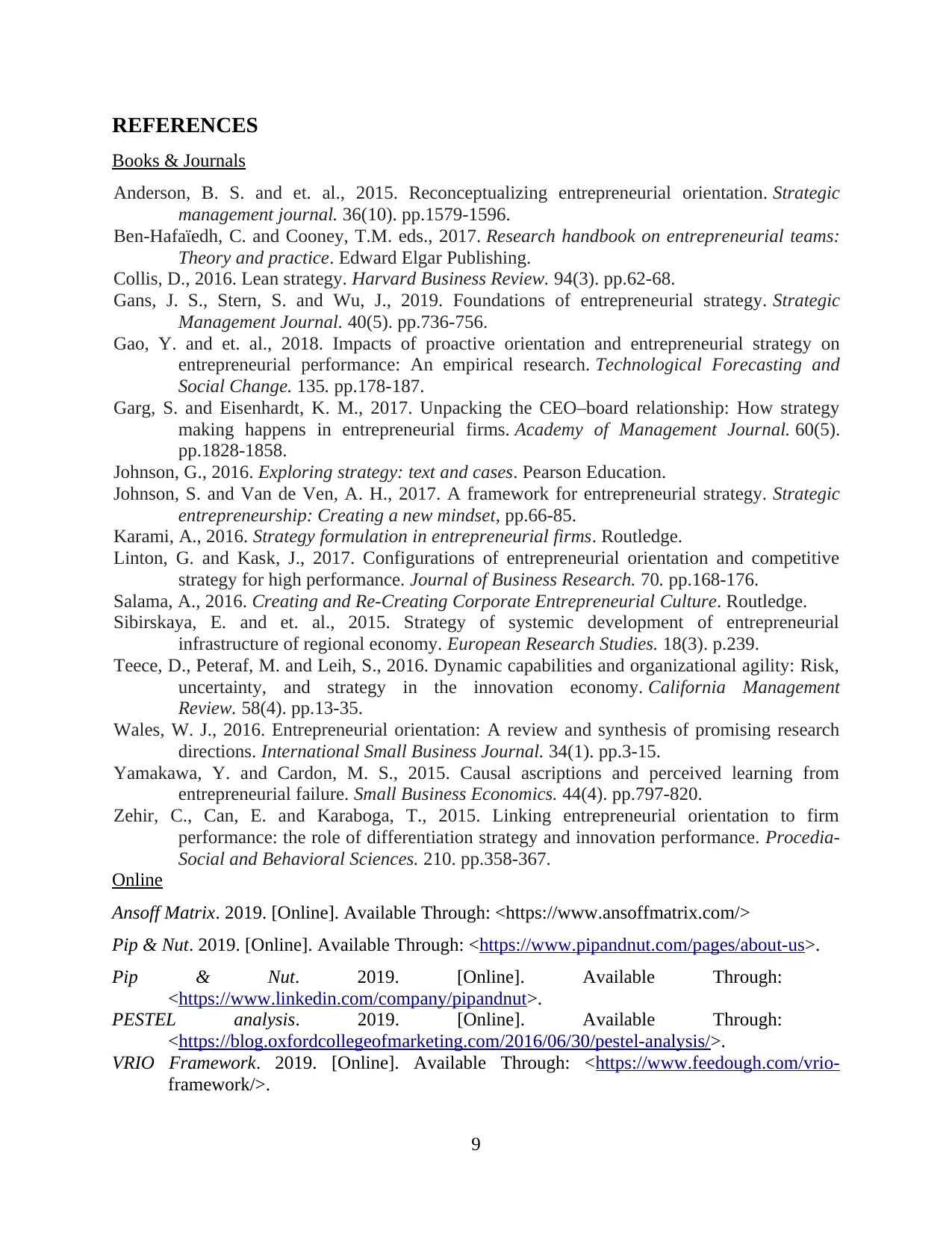
REFERENCES
Books & Journals
Anderson, B. S. and et. al., 2015. Reconceptualizing entrepreneurial orientation. Strategic
management journal. 36(10). pp.1579-1596.
Ben-Hafaïedh, C. and Cooney, T.M. eds., 2017. Research handbook on entrepreneurial teams:
Theory and practice. Edward Elgar Publishing.
Collis, D., 2016. Lean strategy. Harvard Business Review. 94(3). pp.62-68.
Gans, J. S., Stern, S. and Wu, J., 2019. Foundations of entrepreneurial strategy. Strategic
Management Journal. 40(5). pp.736-756.
Gao, Y. and et. al., 2018. Impacts of proactive orientation and entrepreneurial strategy on
entrepreneurial performance: An empirical research. Technological Forecasting and
Social Change. 135. pp.178-187.
Garg, S. and Eisenhardt, K. M., 2017. Unpacking the CEO–board relationship: How strategy
making happens in entrepreneurial firms. Academy of Management Journal. 60(5).
pp.1828-1858.
Johnson, G., 2016. Exploring strategy: text and cases. Pearson Education.
Johnson, S. and Van de Ven, A. H., 2017. A framework for entrepreneurial strategy. Strategic
entrepreneurship: Creating a new mindset, pp.66-85.
Karami, A., 2016. Strategy formulation in entrepreneurial firms. Routledge.
Linton, G. and Kask, J., 2017. Configurations of entrepreneurial orientation and competitive
strategy for high performance. Journal of Business Research. 70. pp.168-176.
Salama, A., 2016. Creating and Re-Creating Corporate Entrepreneurial Culture. Routledge.
Sibirskaya, E. and et. al., 2015. Strategy of systemic development of entrepreneurial
infrastructure of regional economy. European Research Studies. 18(3). p.239.
Teece, D., Peteraf, M. and Leih, S., 2016. Dynamic capabilities and organizational agility: Risk,
uncertainty, and strategy in the innovation economy. California Management
Review. 58(4). pp.13-35.
Wales, W. J., 2016. Entrepreneurial orientation: A review and synthesis of promising research
directions. International Small Business Journal. 34(1). pp.3-15.
Yamakawa, Y. and Cardon, M. S., 2015. Causal ascriptions and perceived learning from
entrepreneurial failure. Small Business Economics. 44(4). pp.797-820.
Zehir, C., Can, E. and Karaboga, T., 2015. Linking entrepreneurial orientation to firm
performance: the role of differentiation strategy and innovation performance. Procedia-
Social and Behavioral Sciences. 210. pp.358-367.
Online
Ansoff Matrix. 2019. [Online]. Available Through: <https://www.ansoffmatrix.com/>
Pip & Nut. 2019. [Online]. Available Through: <https://www.pipandnut.com/pages/about-us>.
Pip & Nut. 2019. [Online]. Available Through:
<https://www.linkedin.com/company/pipandnut>.
PESTEL analysis. 2019. [Online]. Available Through:
<https://blog.oxfordcollegeofmarketing.com/2016/06/30/pestel-analysis/>.
VRIO Framework. 2019. [Online]. Available Through: <https://www.feedough.com/vrio-
framework/>.
9
Books & Journals
Anderson, B. S. and et. al., 2015. Reconceptualizing entrepreneurial orientation. Strategic
management journal. 36(10). pp.1579-1596.
Ben-Hafaïedh, C. and Cooney, T.M. eds., 2017. Research handbook on entrepreneurial teams:
Theory and practice. Edward Elgar Publishing.
Collis, D., 2016. Lean strategy. Harvard Business Review. 94(3). pp.62-68.
Gans, J. S., Stern, S. and Wu, J., 2019. Foundations of entrepreneurial strategy. Strategic
Management Journal. 40(5). pp.736-756.
Gao, Y. and et. al., 2018. Impacts of proactive orientation and entrepreneurial strategy on
entrepreneurial performance: An empirical research. Technological Forecasting and
Social Change. 135. pp.178-187.
Garg, S. and Eisenhardt, K. M., 2017. Unpacking the CEO–board relationship: How strategy
making happens in entrepreneurial firms. Academy of Management Journal. 60(5).
pp.1828-1858.
Johnson, G., 2016. Exploring strategy: text and cases. Pearson Education.
Johnson, S. and Van de Ven, A. H., 2017. A framework for entrepreneurial strategy. Strategic
entrepreneurship: Creating a new mindset, pp.66-85.
Karami, A., 2016. Strategy formulation in entrepreneurial firms. Routledge.
Linton, G. and Kask, J., 2017. Configurations of entrepreneurial orientation and competitive
strategy for high performance. Journal of Business Research. 70. pp.168-176.
Salama, A., 2016. Creating and Re-Creating Corporate Entrepreneurial Culture. Routledge.
Sibirskaya, E. and et. al., 2015. Strategy of systemic development of entrepreneurial
infrastructure of regional economy. European Research Studies. 18(3). p.239.
Teece, D., Peteraf, M. and Leih, S., 2016. Dynamic capabilities and organizational agility: Risk,
uncertainty, and strategy in the innovation economy. California Management
Review. 58(4). pp.13-35.
Wales, W. J., 2016. Entrepreneurial orientation: A review and synthesis of promising research
directions. International Small Business Journal. 34(1). pp.3-15.
Yamakawa, Y. and Cardon, M. S., 2015. Causal ascriptions and perceived learning from
entrepreneurial failure. Small Business Economics. 44(4). pp.797-820.
Zehir, C., Can, E. and Karaboga, T., 2015. Linking entrepreneurial orientation to firm
performance: the role of differentiation strategy and innovation performance. Procedia-
Social and Behavioral Sciences. 210. pp.358-367.
Online
Ansoff Matrix. 2019. [Online]. Available Through: <https://www.ansoffmatrix.com/>
Pip & Nut. 2019. [Online]. Available Through: <https://www.pipandnut.com/pages/about-us>.
Pip & Nut. 2019. [Online]. Available Through:
<https://www.linkedin.com/company/pipandnut>.
PESTEL analysis. 2019. [Online]. Available Through:
<https://blog.oxfordcollegeofmarketing.com/2016/06/30/pestel-analysis/>.
VRIO Framework. 2019. [Online]. Available Through: <https://www.feedough.com/vrio-
framework/>.
9
1 out of 11
Related Documents
Your All-in-One AI-Powered Toolkit for Academic Success.
+13062052269
info@desklib.com
Available 24*7 on WhatsApp / Email
![[object Object]](/_next/static/media/star-bottom.7253800d.svg)
Unlock your academic potential
Copyright © 2020–2025 A2Z Services. All Rights Reserved. Developed and managed by ZUCOL.





